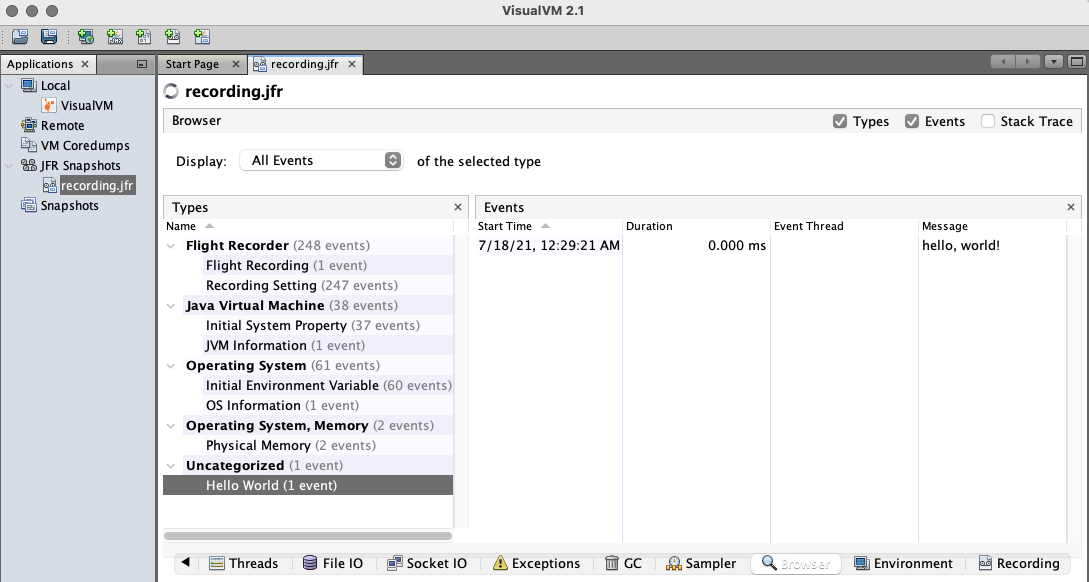◀Table of Contents
Build and Run Native Executables with JFR
JDK Flight Recorder (JFR) is a tool for collecting diagnostic and profiling data about a running Java application, built into a JVM.
GraalVM Native Image supports JFR events and users can use jdk.jfr.Event API with a similar experience to using JFR in the Java HotSpot VM.
To record JFR events when running a native executable, JFR support and JFR recording must be enabled, and this guide covers how to do that.
Note: JFR events recording is not supported on GraalVM distribution for Windows. JFR is only supported with native executables built on GraalVM JDK 11.
Enable JFR Support and Record Events at Run Time
To build a native executable with the JFR events support, you first need to include JFR at build time, then enable the system, start a recording, and configure logging at native executable run time. The following options are supported:
-H:+AllowVMInspection: enable the VM inspection-XX:+FlightRecorder: use to enable JFR-XX:StartFlightRecording: use to start a recording on application’s startup-XX:FlightRecorderLogging: use to configure the log output for the JFR system
Follow the steps below to practice building a native executable with JFR support and recording events at run time.
-
Save the following code to the file named JFRDemo.java.
import jdk.jfr.Event; import jdk.jfr.Description; import jdk.jfr.Label; public class JFRDemo { @Label("Hello World") @Description("Build and run a native executable with JFR.") static class HelloWorldEvent extends Event { @Label("Message") String message; } public static void main(String... args) { HelloWorldEvent event = new HelloWorldEvent(); event.message = "Hello, World!"; event.commit(); } }This demo application consists of a simple class and JDK library classes. It creates an event, labelled with the
@Labelannotation from thejdk.jfr.*package. If you run this application, it will not print anything and just run that event. - Compile the Java file on GraalVM JDK:
$JAVA_HOME/bin/javac JFRDemo.javaIt creates two class files:
JFRDemo$HelloWorldEvent.classandJFRDemo.class. - Build a native executable with the VM inspection enabled:
$JAVA_HOME/bin/native-image -H:+AllowVMInspection JFRDemoThe
-H:+AllowVMInspectionoption enables features such as JFR that can be used to inspect the VM. - Run the executable and start recording:
./jfrdemo -XX:+FlightRecorder -XX:StartFlightRecording="filename=recording.jfr"It runs the application as a native executable. The
-XX:+FlightRecorderflag enables the built-in Flight Recorder and starts recording to a specified binary file,recording.jfr. -
Start VisualVM to view the contents of the recording file in a user-friendly way. GraalVM provides VisualVM in the core installation. To start the tool, run:
$JAVA_HOME/bin/jvisualvm -
Go to File, then Add JFR Snapshot, browse recording.jfr, and open the selected file. Confirm the display name and click OK. Once opened, there is a bunch of options you can check: Monitoring, Threads, Exceptions, etc., but you should be mostly interested in the events browsing. It will look something like this:

Alternatively, you can view the contents of the recording file in the console window by running this command:
$JAVA_HOME/bin/jfr print recording.jfrIt prints all events recorded by Flight Recorder.
Related Documentation
-
Learn more about Native Image support for JFR events and how to further configure JFR recording and system logging.
